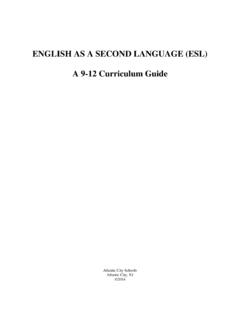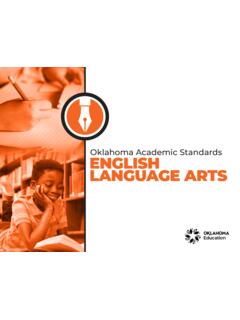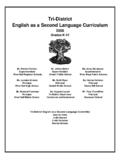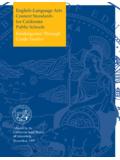Transcription of Learning Objectives for High School English/Language Arts
1 Learning Objectives for high School English/Language arts Contents English/Language arts Program Outcomes .. 2. Competency Goals & Objectives .. 3. Freshman Year Learning Objective .. 8. Sophomore Year Learning Objectives .. 10. Junior Year Learning 12. Senior Year Learning Objectives .. 14. English/Language arts Program Outcomes Before we can intelligently discuss the essentials of effective language arts instruction, we must come to an agreement, so to speak, as to what is the goal. There should be no disagreement to the statement that the overall goal of teaching language arts is to help your students develop the power to communicate effectively for a variety of purposes and in various situations both now and as adults. The following Learning goals describe broad, future-oriented competencies and student behaviors and attitudes.
2 Students who successfully complete a balanced and effective communication skills program: understand the importance composition plays in Godly living and witness; values and uses the written form of his freedom of speech as an active citizen of a democratic republic;. gain insight into and reflects upon his own and other's lives through writing;. take charge of his own life and communicates effectively with others in writing;. become a lifelong learner (inquirer, experimenter, and problem solver) who gains pleasure and fulfillment from writing;. use various composing strategies and processes, such as brainstorming, prewriting, drafting, proofreading, and revising;. write appropriately for different occasions, audiences, and purposes (persuading, explaining, describing, interpreting);. select the standard of english appropriate for both formal and informal situations.
3 Has command of standard composition conventions and mechanics (grammar, usage, and punctuation);. use analysis of language as an editing tool in the composing process;. understands the importance of accurate spelling as an aid to his reader's understanding of what he has written;. appreciate accurate spelling as a common courtesy to his reader;. establish the habit of using spelling, grammar, and vocabulary resources;. establish the habit of using effective proofreading skills on all writing he intends others to read;. use standard formats ( footnoting), various technologies, and legible means to publish his compositions Competency Goals & Objectives The english language arts curriculum is spiraling and contains the same four goals for kindergarten through grade twelve. These goals address the broad purposes for communication.
4 This section describes the specific emphases of each of the four goals. The different Learning Objectives related to these goals for the various grade spans are described in the Grade level Learning Objectives section of this document. The Objectives and focus areas that follow each goal provide further definition. This section identifies sample behaviors that illustrate expected instructional outcomes. Focus areas may also serve as demonstrations of particular Objectives . GOAL 1: The learner will use strategies and processes that enhance control of communication skills development. Objective - The learner will apply PREPARATION strategies to comprehend or convey experiences and information. Apply knowledge of cueing systems (semantic, syntactic, and graphophonic) as appropriate to the nature and purpose of the activity.
5 Set personal goals for the task. Define and analyze assigned task. Anticipate content and organization. Relate prior knowledge and personal experiences to topic. Generate key words or concepts likely to be used in task. Formulate questions to be answered. Consider status and intent of source and creator. Objective - The learner will apply ENGAGEMENT strategies to comprehend or convey experiences and information. Apply knowledge of cueing systems (semantic, syntactic, and graphophonic) as appropriate to the nature and purpose of the activity. Give complete attention to the task. Skim, scan, and note ideas. Search for sense or a lead.. Predict outcomes. Use personal experience while redefining and composing meaning. Review and assess as purpose is defined, clarified, or changed. Discuss and make notes.
6 Verbalize to hear message. Use organization conventions as clues to meaning. Apply strategies to clarify meaning. Objective - The learner will apply RESPONSE strategies to comprehend or convey experiences and information. Focus: Apply knowledge of cueing systems (semantic, syntactic, and graphophonic) as appropriate to the nature and purpose of the activity. Reflect upon the experiences and information. Discuss, outline, or summarize new facts, information, or ideas. Note agreement or disagreement with ideas presented in the selection or activity. Interpret the meaning of, or draw conclusions from, the selection or activity. React to language , form, and literary devices. Ask and respond to probing questions to clarify earlier responses. Identify sources of confusion, problems, differences in interpretation, or new questions that may indicate a need for further study or investigation.
7 Assess own performance relative to the purpose. GOAL 2 - The learner will use language for the acquisition, interpretation, and application of information. Objective The learner will identify, collect, or select information and ideas. Focus: Identify key words and discover their meanings and relationships through a variety of strategies. Identify ways words and concepts are developed. Identify the story structure or organizational patterns of the text, speech, or visual. Recognize details and concepts related to prior predictions and questions. Observe and mentally note or record important information. Objective - The learner will analyze, synthesize, and organize information and discover related ideas, concepts, or generalizations. Focus: Select, reject, and reconcile information and ideas.
8 Condense, combine, and order information. Create an organizational framework for retaining information. Form generalizations based on new information. Compare information and ideas. Analyze the literary and design elements of information and ideas. Classify information and ideas on the basis of attributes. Objective - The learner will apply, extend, and expand on information and concepts. Focus: Use information to clarify or refine understanding of historical or contemporary issues or events. Solve problems, make decisions and inferences, or draw conclusions based on interpretation of information. Follow or produce directions to create a product or develop an idea based on interpretation of information. COMPETENCY GOAL 3 - The learner will use language for critical analysis and evaluation.
9 Objective The learner will assess the validity and accuracy of information and ideas. Focus: Distinguish between vague and precise language . Distinguish between representations of fact and of opinion. Make judgments about the verifiability of information. Identify faulty reasoning. Evaluate the reliability of a source. Evaluate the appropriateness of persuasive techniques. Objective - The learner will determine the value of information and ideas. Focus: Assess scope, comprehensiveness, and significance of information and ideas. Determine practicality and usefulness of information or ideas in light of purposes. Recognize bias, emotional factors, propaganda, and semantic slanting. Objective - The learner will develop criteria and evaluate the quality, relevance, and importance of the information and ideas.
10 Focus: Analyze the effects of word choice, sentence structure, and organization. Make judgments about the clarity, power, and authenticity of information and ideas. Evaluate the effectiveness of the development of plot, theme, setting, and characterization. Determine how purpose, point of view, tone, and style affect judgment of the product, information, and ideas. Evaluate the use of language patterns and literary devices such as figurative language , dialogue, and symbolism. Analyze the use of text aids such as headings, captions, titles, and illustrative material. Compare the effectiveness of a selection in relation to others. Determine the merit of a selection in terms of its timeliness and timelessness. COMPETENCY GOAL 4: The learner will use language for aesthetic and personal response.






